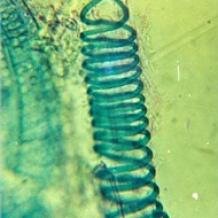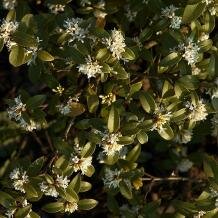Topic: Torus-margo pits in vascular plant xylem
Torus-margo pits probably evolved once in the gymnosperms, after the split of more advanced gymnosperms from the cycads. Surprisingly, eight genera from five families of angiosperms, which are characterised by highly effective xylem vessels, have also evolved torus-margo structures.
 Vascular plants or ‘tracheophytes’ have specialised tissue termed xylem for transporting water and solutes. Xylem cells are elongated and connected end to end to form a tubular water-transport system throughout the plant, continuously replacing the large amount of water lost by evaporation, water that is essential for both photosynthesis (CO2 + H2O → sugars) and to maintain turgor pressure. As plants colonised the land and diversified in the Devonian and Carboniferous many of them became much larger in stature and height.
Vascular plants or ‘tracheophytes’ have specialised tissue termed xylem for transporting water and solutes. Xylem cells are elongated and connected end to end to form a tubular water-transport system throughout the plant, continuously replacing the large amount of water lost by evaporation, water that is essential for both photosynthesis (CO2 + H2O → sugars) and to maintain turgor pressure. As plants colonised the land and diversified in the Devonian and Carboniferous many of them became much larger in stature and height.  For plants to grow taller their water-conduction systems needed to develop improved structural support and higher conduction efficiency, so that water could rapidly reach all the way from the roots to the topmost leaves. Better support for xylem was achieved by (i) rearrangement of vascular and specialist supportive tissues (e.g. parenchyma, sclereids and fibers) and (ii) deposition of lignin as secondary cell wall material in ‘metaxylem’ or ‘secondary’ xylem. Secondary xylem forms part of the woody tissue of shrubs and trees, and is itself convergent, having evolved in the towering lycophyte Lepidodendron, in horse-tails (e.g. Equisetum) and in the lineage containing all gymnosperms and angiosperms. Selection for better hydraulic efficiency (water-conducting ability) in taller plants resulted in two contrasting innovations, both of which are based on modification of ancestral tracheids and show wide convergence.
For plants to grow taller their water-conduction systems needed to develop improved structural support and higher conduction efficiency, so that water could rapidly reach all the way from the roots to the topmost leaves. Better support for xylem was achieved by (i) rearrangement of vascular and specialist supportive tissues (e.g. parenchyma, sclereids and fibers) and (ii) deposition of lignin as secondary cell wall material in ‘metaxylem’ or ‘secondary’ xylem. Secondary xylem forms part of the woody tissue of shrubs and trees, and is itself convergent, having evolved in the towering lycophyte Lepidodendron, in horse-tails (e.g. Equisetum) and in the lineage containing all gymnosperms and angiosperms. Selection for better hydraulic efficiency (water-conducting ability) in taller plants resulted in two contrasting innovations, both of which are based on modification of ancestral tracheids and show wide convergence.  The torus-margo pit membrane evolved in gymnosperms and a very few angiosperms, whereas the xylem vessel element evolved in angiosperms and six other independent lineages: Selaginella, Equisetum, seed-ferns Marsilea and Pteridium, the Gnetales (Gnetum, Ephedra, Welwitschia) and gigantopterids. The following paragraphs explain more about what torus-margo pits are, how they compare with vessels and how they appeared convergently in conifers, Ginkgo, gnetophytes and some angiosperms.
The torus-margo pit membrane evolved in gymnosperms and a very few angiosperms, whereas the xylem vessel element evolved in angiosperms and six other independent lineages: Selaginella, Equisetum, seed-ferns Marsilea and Pteridium, the Gnetales (Gnetum, Ephedra, Welwitschia) and gigantopterids. The following paragraphs explain more about what torus-margo pits are, how they compare with vessels and how they appeared convergently in conifers, Ginkgo, gnetophytes and some angiosperms.
TRACHEIDS, VESSELS AND TORUS-MARGO PITS
 The ancestral water-transport conduit of vascular plants is the tracheid. Tracheids are single, elongated cells up to a maximum of 80µm wide (usually narrower) with secondary, lignified cell walls. In early-formed ‘proto-xylem’, secondary lignin is deposited in rings or spirals around the primary cell wall, strengthening while permitting expansion during growth. In later-formed ‘meta-xylem’ or ‘secondary xylem’ secondary lignin covers the whole primary cell wall, except at gaps called ‘pit-pairs’ between adjacent cells. Pit-pairs are concentrated at the axial ‘end-walls’ between cells, forming a pitted region called a porous pit membrane. Mature tracheid cells lose their protoplast (nucleus and cytoplasm) and die, creating an open structure for water flow, only retarded by the cellulose barrier of the porous pits. Tracheid pits typically contain a membrane of tiny pores that in the case of air entry create a seal by capillary action, thus preventing further air ‘seeding’ or cavitation as the conduit refills.
The ancestral water-transport conduit of vascular plants is the tracheid. Tracheids are single, elongated cells up to a maximum of 80µm wide (usually narrower) with secondary, lignified cell walls. In early-formed ‘proto-xylem’, secondary lignin is deposited in rings or spirals around the primary cell wall, strengthening while permitting expansion during growth. In later-formed ‘meta-xylem’ or ‘secondary xylem’ secondary lignin covers the whole primary cell wall, except at gaps called ‘pit-pairs’ between adjacent cells. Pit-pairs are concentrated at the axial ‘end-walls’ between cells, forming a pitted region called a porous pit membrane. Mature tracheid cells lose their protoplast (nucleus and cytoplasm) and die, creating an open structure for water flow, only retarded by the cellulose barrier of the porous pits. Tracheid pits typically contain a membrane of tiny pores that in the case of air entry create a seal by capillary action, thus preventing further air ‘seeding’ or cavitation as the conduit refills.
Vessels are multi-cellular structures, their main specialisation being that they are on average 7.7 times longer and much wider than tracheids, reducing the number and area of pit membrane barriers in the system and therefore increasing water-conducting efficiency. In addition, the cell walls of vessel pit plates completely break down leaving a ‘perforation plate‘, and although the very small size of individual pits (needed for effective capillary sealing) makes them significantly resistant to water flow, in some plants the plates largely or completely disappear, leaving an open structure with enhanced conductivity.
 Torus-margo pits are specialisations associated with rounded or oval-shaped pits in narrow xylem conduits, either tracheids or narrow fibre-like (‘fibriform’) vessels. The ‘torus’ is an impermeable, typically lignin-based thickening at the centre of the pit membrane, surrounded by a ‘margo’, which is a ring of radial slits or pores that can be much larger than pores in a capillary-sealing membrane. In conifers for example, gaps in the margo are around 0.1µm diameter, exceedingly reducing water flow resistance relative to a typical pit membrane. Indeed, the absolute water-conductivity of an equal area of pit membrane is about 60 times lower in a conifer tracheid versus an angiosperm vessel plate.
Torus-margo pits are specialisations associated with rounded or oval-shaped pits in narrow xylem conduits, either tracheids or narrow fibre-like (‘fibriform’) vessels. The ‘torus’ is an impermeable, typically lignin-based thickening at the centre of the pit membrane, surrounded by a ‘margo’, which is a ring of radial slits or pores that can be much larger than pores in a capillary-sealing membrane. In conifers for example, gaps in the margo are around 0.1µm diameter, exceedingly reducing water flow resistance relative to a typical pit membrane. Indeed, the absolute water-conductivity of an equal area of pit membrane is about 60 times lower in a conifer tracheid versus an angiosperm vessel plate.  The torus functions to seal off the pit opening in case of air entry, protecting the membrane from ‘air seeding’ and potential blockage as refilling cannot occur if new bubbles and cavitation develop. The supremely low resistance of water passing through the margo means that the hydraulic efficiency of torus-margo bearing plants equals or in some cases supercedes that of vessel elements, whose hydraulic efficiency is more connected to their much greater length and width. This efficiency may help explain why the conifers are so ecologically successful, and why they include the tallest trees on earth – the California Redwood, Sequoia sempervirens.
The torus functions to seal off the pit opening in case of air entry, protecting the membrane from ‘air seeding’ and potential blockage as refilling cannot occur if new bubbles and cavitation develop. The supremely low resistance of water passing through the margo means that the hydraulic efficiency of torus-margo bearing plants equals or in some cases supercedes that of vessel elements, whose hydraulic efficiency is more connected to their much greater length and width. This efficiency may help explain why the conifers are so ecologically successful, and why they include the tallest trees on earth – the California Redwood, Sequoia sempervirens.
OCCURENCE OF TORUS-MARGO PITS IN GYMNOSPERMS AND ANGIOSPERMS
 Ginkgo biloba” width=”218″ height=”218″>Our current understanding of the pattern of plant diversification suggests that torus-margo pitting probably evolved once in the gymnosperms, after the split of more advanced gymnosperms from the cycads in the Carboniferous. Cycad tracheids have circular pits without any torus-margo structures, but the latter are found in all higher gymnosperm groups, including extant Ginkgo, conifers and the Gnetales (Ephedra, Gnetum and Welwitschia).
Ginkgo biloba” width=”218″ height=”218″>Our current understanding of the pattern of plant diversification suggests that torus-margo pitting probably evolved once in the gymnosperms, after the split of more advanced gymnosperms from the cycads in the Carboniferous. Cycad tracheids have circular pits without any torus-margo structures, but the latter are found in all higher gymnosperm groups, including extant Ginkgo, conifers and the Gnetales (Ephedra, Gnetum and Welwitschia).
 Surprisingly, eight genera from five families of angiosperms, which are characterised by highly effective xylem vessels, have also evolved torus-margo structures. Where they do occur, angiosperm torus-margos are restricted to very narrow conduits, either in narrow tracheids, fiber-tracheids or fibriform vessels. Angiosperm margo pores may exceed 1000nm in size, but typically they are 100-50 nm wide, which is too small to allow flow as efficient as that in conifers, although it does enhance capillary force to protect against air entry.
Surprisingly, eight genera from five families of angiosperms, which are characterised by highly effective xylem vessels, have also evolved torus-margo structures. Where they do occur, angiosperm torus-margos are restricted to very narrow conduits, either in narrow tracheids, fiber-tracheids or fibriform vessels. Angiosperm margo pores may exceed 1000nm in size, but typically they are 100-50 nm wide, which is too small to allow flow as efficient as that in conifers, although it does enhance capillary force to protect against air entry.
 Osmanthus is a member of the order Lamiales, in the family Oleaceae. As such it is part of the large angiosperm group ‘Euasterids II’, very disparate from the ‘Eurosids’ in which all other torus-margo angiosperms have been found. Two distinct branches of the Eurosids (I and II) are defined, and within Eurosids I we find five genera in the order Rosales, within which all or some of the species show torus margo pits. These include Cercocarpus (Rosaceae), Celtis (Cannabaceae) and three genera in the Ulmaceae: Ulmus, Planera and Zelkova. Finally, in the Eurosids II, we find Daphne and Wikstroemia, of the order Malvales and family Thymelaceae.
Osmanthus is a member of the order Lamiales, in the family Oleaceae. As such it is part of the large angiosperm group ‘Euasterids II’, very disparate from the ‘Eurosids’ in which all other torus-margo angiosperms have been found. Two distinct branches of the Eurosids (I and II) are defined, and within Eurosids I we find five genera in the order Rosales, within which all or some of the species show torus margo pits. These include Cercocarpus (Rosaceae), Celtis (Cannabaceae) and three genera in the Ulmaceae: Ulmus, Planera and Zelkova. Finally, in the Eurosids II, we find Daphne and Wikstroemia, of the order Malvales and family Thymelaceae.
 The torus is typically formed as a secondary deposit of lignin at the centre of the pit membrane (e.g. in gymnosperms and the angiosperms Daphne and Osmanthus), but in a few angiosperms it be composed of pectin and cellulose, deposited as a thickening of the primary cell wall (e.g. in Ulmus and Celtis). These different mechanisms of torus formation, as well as the wide evolutionary separation between gymnosperms and angiosperms possessing torus-margo pits highlights the striking degree of convergence associated with this superbly low-resistance water-conduction device.
The torus is typically formed as a secondary deposit of lignin at the centre of the pit membrane (e.g. in gymnosperms and the angiosperms Daphne and Osmanthus), but in a few angiosperms it be composed of pectin and cellulose, deposited as a thickening of the primary cell wall (e.g. in Ulmus and Celtis). These different mechanisms of torus formation, as well as the wide evolutionary separation between gymnosperms and angiosperms possessing torus-margo pits highlights the striking degree of convergence associated with this superbly low-resistance water-conduction device.
Cite this web page
Map of Life - "Torus-margo pits in vascular plant xylem"
https://mapoflife.org/topics/topic_452_torus-margo-pits-in-vascular-plant-xylem/
March 3, 2021

